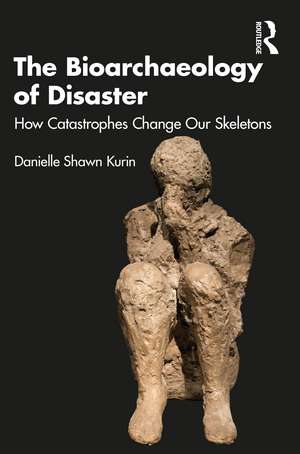The Bioarchaeology of Disaster: How Catastrophes Change our Skeletons
Autor Danielle Shawn Kurinen Limba Engleză Paperback – 26 noi 2021
Each case study provides the social, cultural, historical and ecological context of the disaster and then analyzes evidence of human and related remains in order to better understand the identities of victims, the means, processes, and extent of deaths and injuries. The methods used by specialists to interpret evidence and disagreements among experts are also addressed. It will be helpful in understanding the circumstances of a range of disasters and the multidisciplinary ways in which bioarchaeologists employ empirical methods and analytic frameworks to interpret their impacts and consequences.
The book is intended for those in the social and biological sciences, particularly archaeology, forensics, history and ethnography. It will also be of interest to those in medical history and epidemiology, ecological studies, and those involved in disaster response, law enforcement and human rights work.
Preț: 250.78 lei
Preț vechi: 298.11 lei
-16% Nou
Puncte Express: 376
Preț estimativ în valută:
47.99€ • 49.82$ • 40.02£
47.99€ • 49.82$ • 40.02£
Carte tipărită la comandă
Livrare economică 22 martie-05 aprilie
Preluare comenzi: 021 569.72.76
Specificații
ISBN-13: 9781032135830
ISBN-10: 1032135832
Pagini: 236
Ilustrații: 24 Halftones, black and white; 24 Illustrations, black and white
Dimensiuni: 152 x 229 x 27 mm
Greutate: 0.62 kg
Ediția:1
Editura: Taylor & Francis
Colecția Routledge
Locul publicării:Oxford, United Kingdom
ISBN-10: 1032135832
Pagini: 236
Ilustrații: 24 Halftones, black and white; 24 Illustrations, black and white
Dimensiuni: 152 x 229 x 27 mm
Greutate: 0.62 kg
Ediția:1
Editura: Taylor & Francis
Colecția Routledge
Locul publicării:Oxford, United Kingdom
Cuprins
Introduction; Part I: Natural Catastrophes: Earthquakes, Volcanoes, Hurricanes, and Floods; 1. Eruption of Mount Vesuvius and the Destruction of Pompeii, 79 A.D.; 2. Hurricane Katrina, New Orleans, 2005; 3. Haitian Earthquake, 2010; Part II: Human Environmental Disasters; 4. Ecocide in Norse Greenland, 15th Century; 5. Deforestation of Easter Island, 17th Century; Part III: Biological Disasters: Epidemics and Famines; 6. The Black Death of Europe and the Middle East, 1346–1353; 7. Syphilis Crosses the Atlantic, 15th Century; 8. Jamestown, Virginia, Starving Time of 1609–1610; 9. New England’s Vampire Panic, 19th Century; 10. Irish Potato Famine, 1845–1852; Part IV: Industrial and Occupational Hazards and Calamities; 11. Soot Wart Cancer Among British Chimney Sweeps, 18th–19th Centuries; 12. Accidents in South Africa’s Kimberley’s Big Hole Diamond Mine, 1880–1890s; Part V: Catastrophes of Human Conflict: Terrorism, Genocide, and War; 13. Chanka Communal Violence in the Andes, 11th–15th Centuries; 14. Smallpox in Colonial America, 16th–18th Centuries; 15. U.S. Civil War Amputations and Prosthetics, 1861–1865; 16. Killing Fields of Cambodia, 1975–1979; 17. Crash of Pan Am 103 in Lockerbie, Scotland, 1988; 18. Rwandan Genocide, 1994; Part VI: Calamities and Abuse of the Socially Marginalized: Identity, Stigma, and Persecution; 19. Sati, Widow Burning in India, 10th–19th Centuries; 20. Eunuchs of China’s Ming Dynasty, 16th–17th Centuries; 21. Mutiny of the Batavia, Indian Ocean, 1629; 22. Yakuza of Japan, 17th–21st Centuries; 23. Infanticide and Abortion in Five Points, New York, 19th Century; 24. Kalawao Leper Colony, Hawaii, 19th–20th Centuries; Conclusion; Index
Notă biografică
Danielle Shawn Kurin is Associate Professor, Department of Anthropology, and Director of the Phillip Walker Bioarchaeology Lab at the University of California, Santa Barbara. She received her Ph.D. from Vanderbilt University and her A.B. from Bryn Mawr College. A former Fulbright Fellow, she has received research support from institutions such as the National Science Foundation.
Descriere
The Bioarchaeology of Disaster examines two dozen disasters occurring around the world over the past 2000 years, ranging from natural and environmental disasters to human conflict and warfare, from epidemics to those of social marginalization.
